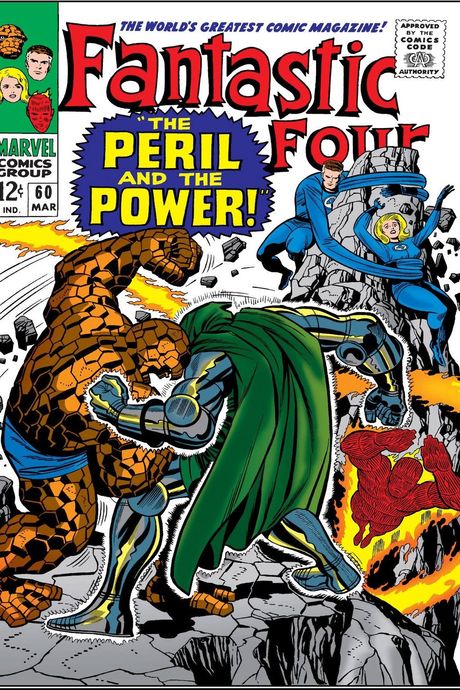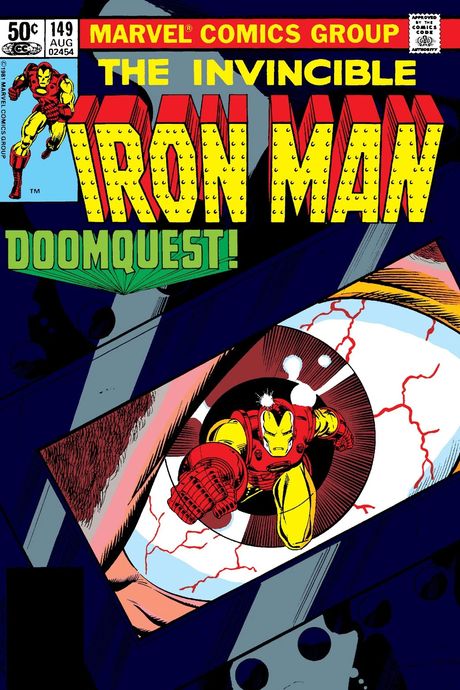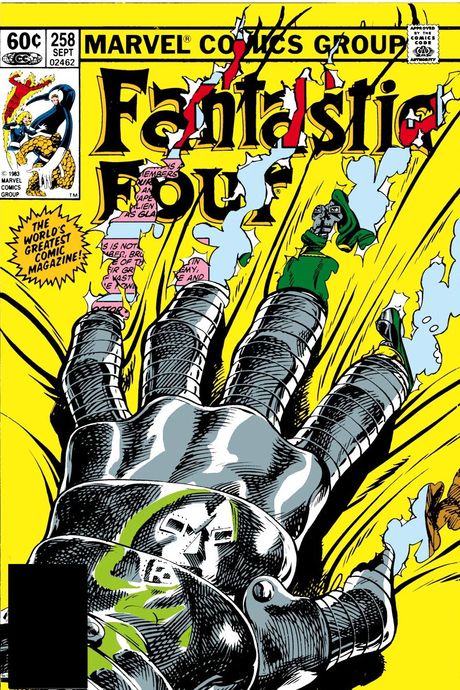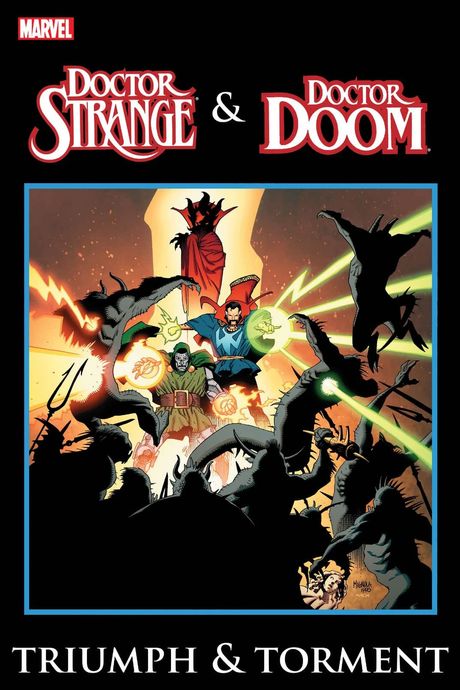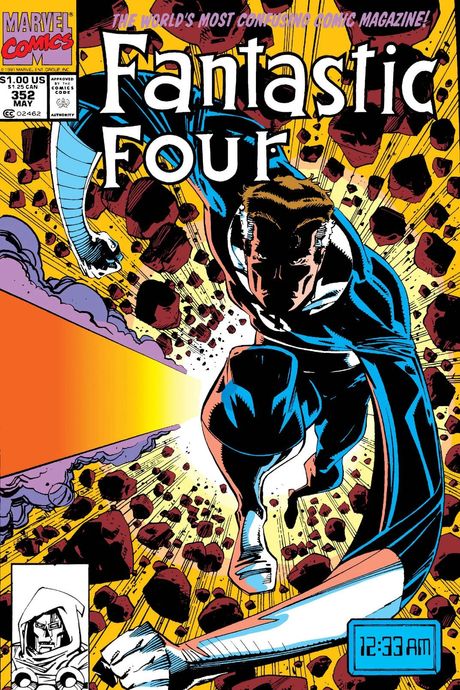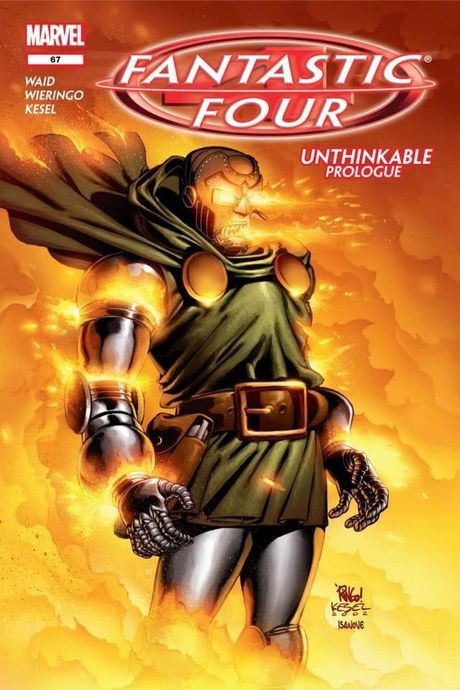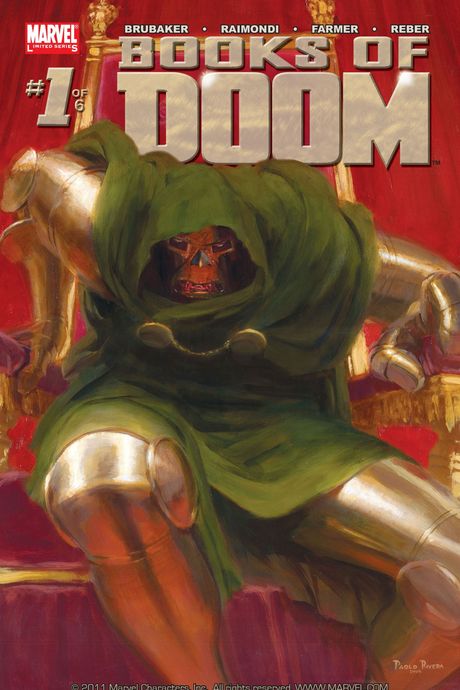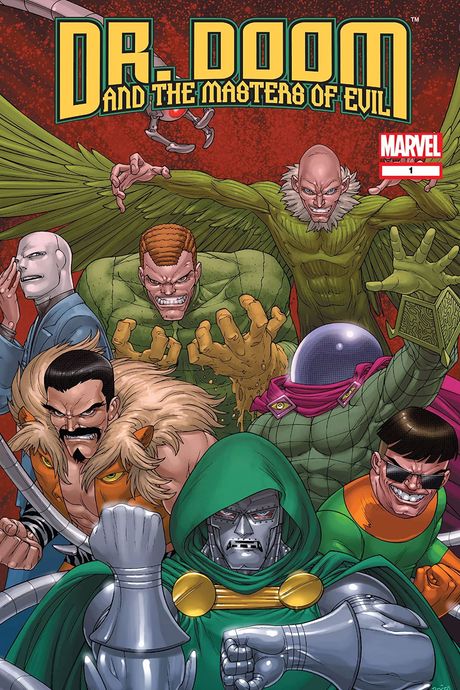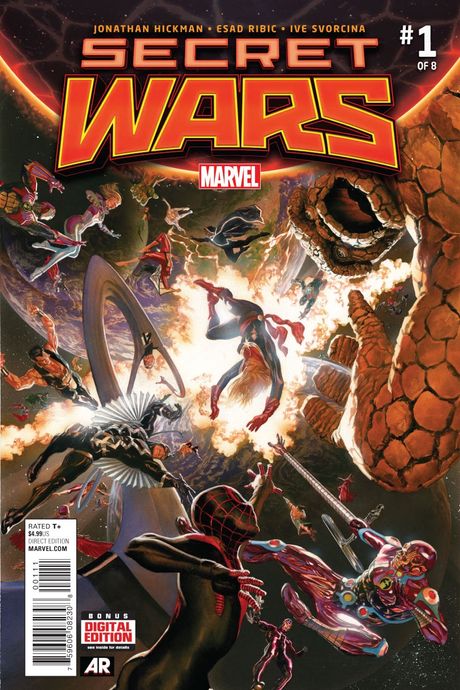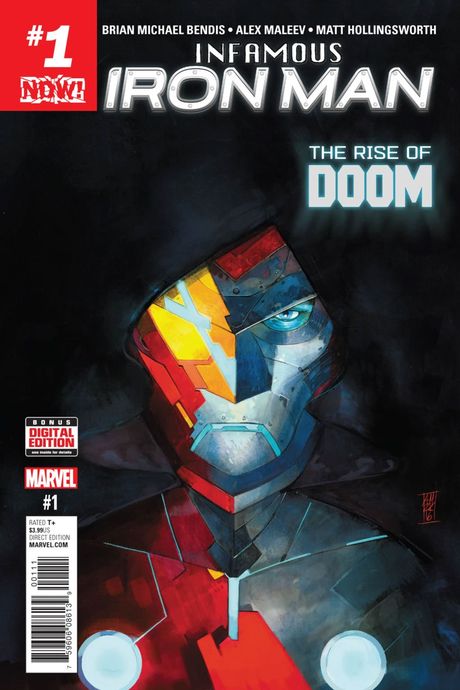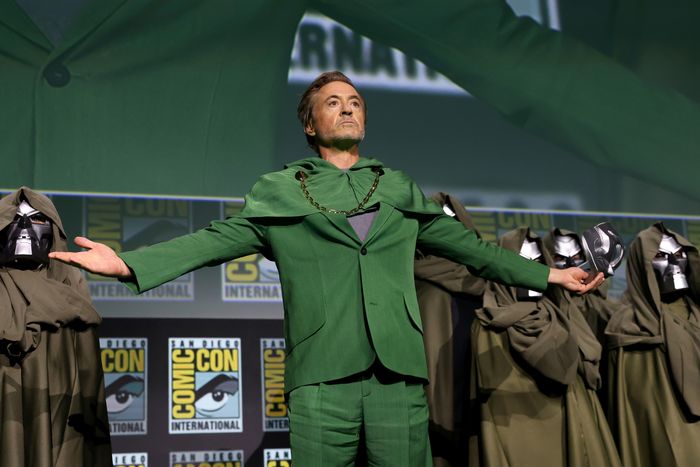
We’re just a few days removed from Marvel Studios confusing us all by revealing that its most beloved Good Guy, former Iron Man Robert Downey Jr., is set to return to the Marvel Cinematic Universe not as Iron Man but as one of the company’s biggest, baddest supervillains.
In just a couple of years, Downey will return to the MCU as Doctor Doom, taking the role of the central Big Bad for the next two Avengers films. It’s a casting decision that has the whole of Marvel fandom talking, but if you’re not as dialed in to the comic-book origins of these movies as the rest of us, you might just be going Wait, what? over and over.
So who is Doctor Doom? What does Downey stand to gain by playing the role? How can you, a moviegoer who’s barely familiar with the character, get to know the MCU’s next great megavillain? We’re here to help. Here are ten comic-book stories that’ll prime you for Doctor Doom fandom, plus a peek at his limited onscreen presence thus far.
“The Peril and the Power!” (Fantastic Four No. 57–No. 60, 1966)
The first of Marvel’s A-list supervillains to make his appearance, Doctor Doom debuted in Fantastic Four No. 5 back in the summer of 1962 and emerged immediately as a major threat to the company’s first superhero team. A scientist, warrior, supercriminal, and absolute monarch of the fictional Eastern European nation of Latveria, Victor Von Doom immediately established himself as a bombastic presence with incredible power, and while his origin story does get a bit more complicated, that’s basically all you need to know to get started.
Doom was created by Marvel Comics legends Stan Lee and Jack Kirby, and while they’d return to him several times over the course of their Fantastic Four run, Doom arguably never got better in his early years than he did in this story, in which he steals the Power Cosmic (and the space surfboard) from the Silver Surfer. It’s a power grab of monumental proportions, and it reveals just how ambitious Doom really is when it comes to beating Mr. Fantastic and his team at all costs.
“Doomquest” (Iron Man No. 149–No. 150, 1981)
Given the new Downey Jr. link between the characters, you’ve probably been wondering if Iron Man and Doctor Doom have ever gone toe to toe, and you’re in luck. The characters squared off in 1981 under the care of writers David Michelinie and Bob Layton and artist John Romita Jr., and the results are as bonkers as they are fun. An argument over stolen technology sends Iron Man to Doom’s castle, where a fight eventually puts them in contact with Doom’s time machine and zips them back to the age of King Arthur (yes, King Arthur is part of the Marvel universe, because comics are fun), where they take opposite sides in the struggle against good and evil and eventually have to team up to get back home. It’s a blast to read, and it lays a lot of groundwork for just how similar the two characters are, which would pay off in future stories (more on that later).
“Interlude” (Fantastic Four No. 258, 1983)
John Byrne’s legendary run on Fantastic Four is full of great Doom moments, but “Interlude” is a particularly important story for our purposes, because it’s a rare chance for Doom to push the titular foursome aside and take center stage in an issue of the comic.
In the midst of rebuilding his kingdom after a usurper ran it into the ground (long story), Doom spends this issue plotting, spending time with his young ward Kristoff (Mr. Fantastic’s half-brother — again, long story), and of course making ruthless moves as part of his ultimate plan to defeat the Fantastic Four. It’s a wonderful little peek into Doctor Doom’s inner life, and it speaks volumes about who he is as a character — as arrogant as he is relentless and driven, but not without moments of tenderness.
Doctor Strange and Doctor Doom: Triumph and Torment (1989)
Doom is, of course, one of Marvel’s great supervillains, but that doesn’t mean he’s incapable of playing nice with others. When it suits Doom, he’ll team up with just about anybody to get what he wants, and in this case that mentality leads him to the Sorcerer Supreme, Doctor Strange.
Doom wants Strange’s help to get his long-lost mother out of fellow Marvel villain Mephisto’s hell (not to be confused with the hell of Doctor Strange in the Multiverse of Madness), and while Strange agrees, both men get more than they bargained for when they journey through the Marvel underworld and learn some surprising truths about each other along the way. It’s an excellent dive into the more magical side of Doom, a great team-up story, and an example of just how adaptable the character can be.
“No Time Like the Present!” (Fantastic Four No. 350–No. 352, 1991)
Walt Simonson, arguably the greatest Thor writer-artist to ever take the helm of that character’s stories, also turned in an incredible run with the Fantastic Four, and while his whole tenure is worth reading, this might be the apex. The story follows Doctor Doom as he makes a triumphant return to Latveria after it was ruled by an impostor. Once he’s established that he is indeed the real thing, he sets out trying once again to destroy the Fantastic Four, and this time Reed Richards wants to go toe to toe with his archenemy. Their fight unfolds over the entirety of issue No. 152; It’s done with the help of a time-traveling device, which means they blip through time with each new punch thrown. For added fun, Simonson added timecodes to each page so you can read in order from page one to the end, then go back and reread the issue in the order of the timecodes. It’s a brilliant story device and a great Doctor Doom showdown.
“Unthinkable” (Fantastic Four No. 67–No. 70 & Fantastic Four No. 500, 2003)
Writer Mark Waid and artist Mike Wieringo (who died of an aortic dissection in 2007 while working on a Fantastic Four What If? story) turned in one of the Fantastic Four’s great revitalizing runs in the early aughts, and this story arc marks the thrilling centerpiece of everything they set out to build.
“Unthinkable” follows yet another plot by Doom to destroy the Fantastic Four, but unlike his previous gambits, which rested largely on his technological prowess, this time Doom is after something else. He sees magic as the way to victory this time, and he’ll go to some very, very dark places to get it. What follows is one of the most emotionally intense battles these heroes and this villain have ever faced, and that’s really saying something.
Books of Doom (2006)
Doctor Doom is a character with a remarkable ego and an even more remarkable ability to back that ego up. Perhaps more than any other villain in Marvel Comics, he simply believes that he is better than everyone else, more capable and more deserving. That informs a lot of his character choices, and while you can figure that out from reading about straight-up battles with the Fantastic Four, sometimes it’s nice to take a step back and do a deep dive.
In Books of Doom, writer Ed Brubaker and artist Pablo Raimondi offer exactly that, an in-depth life story for the character that digs into his childhood brushes with dark magic, his rise through the ranks of power, his academic prowess, and much more. This guy’s had a long, weird, often cruel life, and he pours it all into his villainy.
Doctor Doom and the Masters of Evil (2009)
This four-issue miniseries from writer Paul Tobin and a rotating crew of artists didn’t make a gigantic impact on the history of the Marvel Universe and might be the most obscure title on this list. But that doesn’t mean it isn’t worth reading.
In fact, this story — in which Doom assembles a team of supervillains from across the Marvel universe (Magneto, Mysterio, Vulture, etc.) to reach a spot of great magical significance so that he can ask for one wish to be granted — contains what might be the most important insight into Doom as a character in any comic-book story ever published about the character. It’s a fun supervillain adventure story, but it culminates in a way that sums up the character and what he values like no other modern comic-book story ever has.
Secret Wars (2015)
You’ve probably already got Secret Wars on your reading list because of its importance to future Avengers movies, but beyond the heroes, this is a particularly important study of the central villain.
Written by Jonathan Hickman and drawn by Esad Ribic, the crossover-event series is set in a kind of pocket dimension where the survivors of the Marvel Universe’s destruction have reorganized society into a vast kingdom overseen by Doom, who’s established himself as God Emperor after saving everyone through sheer force of will. It’s a remarkable study in the way Doom uses and sometimes chafes at his own power, a great superhero epic, and a surprisingly moving crossover event that might be among the best comics of its kind ever.
Infamous Iron Man (2016)
In the mid-2010s, during the Civil War II event, Tony Stark died. Don’t worry, he got better, but while Stark was out of commission, a new Iron Man was left to rise up and take over the mantle. That Iron Man was, very interestingly for our Downey Jr.–adjacent purposes, Victor Von Doom. Trading in his own trademark armor for a version of the Iron Man suit, Doom sets out on a somewhat mysterious quest for redemption, trying out the whole superhero thing while searching his own emotional past for evidence that he can indeed avoid the dark fate that seems to be laid out for him. It’s a very fun twist on the character, an in-depth look at who Doom is in the present of the Marvel Universe, and since we’re about to have one actor playing both characters, a really interesting look at the overlap between two tech-savvy Über-rich men with God complexes.
.
A Brief History of Doctor Doom on the Big Screen
Of course, Doctor Doom’s past is taken up not just by comics or in toy aisles, video games, and animated series. The character has also made multiple trips to the multiplex over the years, so let’s take a quick look back at that journey so far.
In 1994, Doom made his cinematic debut alongside the rest of the Fantastic Four in Roger Corman’s legendary low-budget Fantastic Four film, which you can still find floating around online in various forms. Just like in the comics, this Doom was a college friend of Reed Richards’s who ended up scarred due to a horrific accident that ultimately made him Reed’s sworn enemy. It’s not a great film, but Doom’s costume does look action-figure perfect, so there’s that.
Doom returned to the screen in 2005, this time with a wide theatrical release, for Fox’s Fantastic Four film. Julian McMahon stepped into the armor for this one, which tweaked the character’s origin so he gets his powers and madness from basically the same place the Four get their good-guy gifts. It’s not a tweak that necessarily works in Doom’s favor, but the movie is fun enough, and he did get to stick around for the sequel, 2007’s Fantastic Four: Rise of the Silver Surfer.
A decade later, Doom popped up in an even more mutated form in Josh Trank’s Fantastic Four, this time as a computer programmer who manages to join the would-be superhero team on a journey to an alternate dimension, where strange substances turn him into a weird-looking humanoid monster with various superpowers. He’s barely recognizable as Doom if you know the character from the comics, but hey, at least they tried something different.
So how will Downey’s turn with the character work? Is he an alternate-universe Iron Man? Is he just Downey in a mask the whole time so we never see that he looks exactly like Tony Stark? Is it something else entirely? We’ll find out soon enough. The character’s journey likely begins with an introduction in The Fantastic Four: First Steps, in theaters next July.


